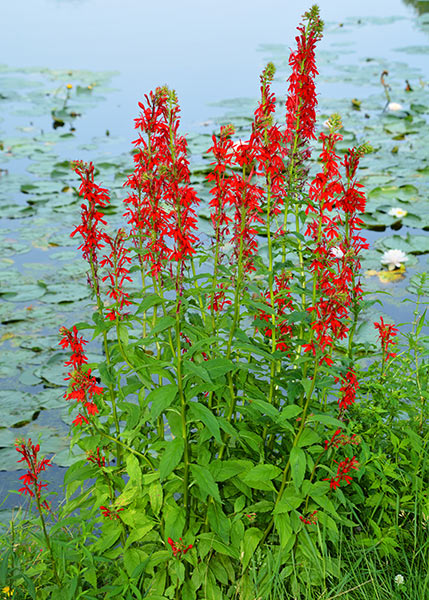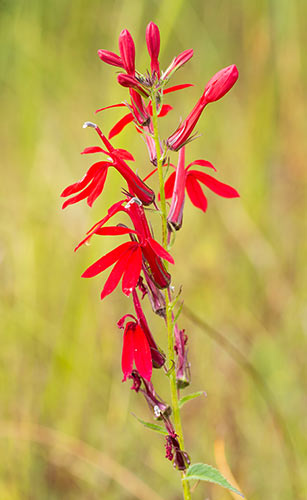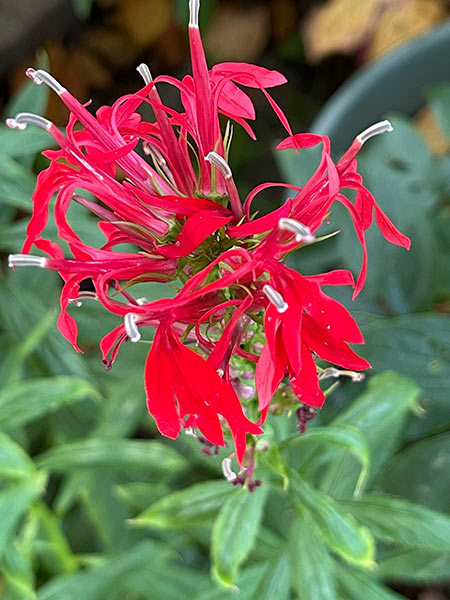
Cardinal flower (Lobelia cardinalis) is a perennial native plant that blooms from mid-summer to fall. The flowers on the bottom of its tall stalk bloom first, gradually opening to the top of the stem. It is also known as red cardinal plant or red cardinal flower.
Colorful Plant for Moist Soils – How to Grow Cardinal Flower
This native plant is a blessing for the moist soil areas of your garden. It has bright red flowers and grows in shade, part-shade, or full sun.
Its versatile light requirements mean it can be planted in various locations, whether you have a pond or stream, a swampy area, or a ditch you wish to fill in with flowers.
We have a spot in our backyard that the front yard drains into. It stays wet most of the time, resulting in mud that gets tracked into our house by the dogs.
I’ve struggled with what to do with this area for a while. I finally decided to convert it into a garden for moist soil plants. I bought three cardinal flowers this weekend to start it out.
Water Requirements
Cardinal flower prefers moist to wet soils and will struggle in soil that dries out completely. It has a medium to high water requirement. In wet soils, it can tolerate heat and full sun.
You can even grow this plant in a container, though you have to ensure soil in the pot stays moist.
Native Range & Hardiness Zone
This plant is native to much of the Eastern U.S., parts of Canada and Mexico, and Central America. It is hardy in USDA zones 3 to 9.
You should add mulch around the roots in colder climates to protect them and keep the soil moist. The basal rosettes overwinter, so be sure not to let them get covered with leaves or other debris.
Plant Height
In the winter, only the basal rosettes persist, which hug the ground. When in bloom, cardinal flower can reach a height of 2 to 4 feet.
Wildlife Value of Cardinal Flower

The bright red flower provides nectar to hummingbirds, bees, moths, and butterflies. It is moderately deer resistant, although deer will browse on young plants.
Name Derivation
While the flower is red like a male cardinal, that’s not the source of its common name. The common name cardinal flower stems from the flowers’ resemblance to the vestments worn by cardinals of the Catholic Church.
Propagating Cardinal Flower
How to Grow This Flower from Seed
To propagate this native plant from seed, collect the seeds when they ripen in fall and sow on open soil. They require sunlight to germinate.
How to Propagate It from Divisions
This plant has a basal rosette from which the flower spike grows. As the original rosette dies after flowering, it will create new rosettes at the side of the parent plant. You can dig the plant up and separate these new rosettes to develop new plants.
How to Grow It from Cuttings

Cardinal flowers can also be propagated by ground layering. Take a stem and bend it towards the ground, dig a small trench to place a portion of the stem, cover it with soil, and weigh it down with a stone or brick. After a couple of weeks, you can cut the stem from its original plant, dig it up, and transplant it. Try this method early in the flowering season (mid-summer).
Great Plant Color Combinations – Companion Plants
For wet soils, these plants make great color combinations with cardinal flowers:
- Swamp mallow (also red, but a much greater height)
- Marsh milkweed
- Louisiana irises (the purples, yellows, and whites make a great color contrast)
- Blue cardinal flower (Lobelia silphitica) – a great contrasting color
